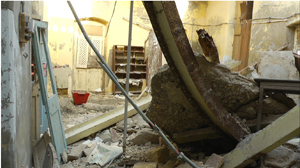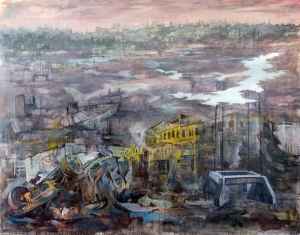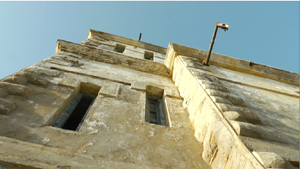Contemporary Artist Naiza Khan and Her Investigation of Urban Space
Urban landscapes have provided an area of great interest for photographers and artists, especially urban areas that have failed to meet their potential or have gradually disintegrated since previous days of glory. Not only do these landscapes provide interesting material for artists but can also be perceived as a visual commentary on the state of urbanization around the world, thereby representing an important post-industrial issue and forcing the viewer to literally confront the topic of disintegrating urban space by simply looking at the work.

Photographing and creating art that depicts deteriorating urban landscapes brings attention to the area and it useful, at least in the sense that the urban area has become the subject of an interesting photograph or painting, which can reinvigorate the area in a way. If a city is declining, it serves little purpose and continues to rot away, with violent crime and political mismanagement running rampant. However, when artists and photographers are working around these failing urban spaces and abandoned cities (a prevalent example of this in the United States is Detroit, a failing major U.S. city that recently filed for bankruptcy protection and whose population is disproportionate to the size of the city) it brings attention to the issues surrounding declining cities yet illuminates a city’s potential through the artists’ work.
Artist Naiza Khan has explored the urban landscape in Karachi, Pakistan where she currently lives and works and has managed to incorporate her feelings about this city, and ultimately, the country of Pakistan, into her art. Khan also works on Manora Island, a small island off the coast of Pakistan near Karachi, bringing attention to the landscape there, or as she calls it, the interrupted geography.
Khan was born in 1968 in Bahawalpur, Pakistan and raised in England where she went on to study at Ruskin School of Drawing and Fine Art, University of Oxford, and Wimbledon College of Art, University of the Arts, London. Khan’s first solo exhibition in the United States was at the Broad Art Museum in East Lansing, Michigan from February 22 through May 26, 2013. This exhibit focused on some her feminist work and featured photography of Manora Island as well as a video work titled The Observatory which consists of footage of an abandoned lighthouse with a ruined interior.
Through her work, she recalls the uneven and slow effort to turn Manora Island into a stylish and exotic location, similar to Dubai. In this way, Khan picks up where the government leaves off in the patchwork of locals, tourism, and military that is Manora Island in its current state and turns it into an artwork itself, especially as she continues to work there and use it as inspiration for future work.

In Khan’s The Streets Are Rising, the urban landscape portrayed is one of decimation, desolation, and pollution. The entire painting feels hazy, as if the air is thick with smoke or smog. In the lower left corner is a car that is completely wrecked and flipped upside-down in the midst of a street covered in debris, looking like the aftermath of a riot or bomb. The first thing the viewer will notice is the car, their gaze then moving up the painting to the street, to the water, and to the city skyline painted in the distance. The dichotomy of the beautiful pastel colors and the somber view is a saddening reminder that an aesthetically pleasing piece can simultaneously please the eye and depict a painful reality.
A painting like Khan’s The Streets Are Rising can spread awareness to viewers across the globe, wherever her work travels. This painting evokes chaos, a kind of chaos that most Americans live quite far from but is reality for millions across the globe. It stirs feelings of uncertainty and loss; it represents the crumbling leftovers of urbanization, what’s left after a city is abandoned–the image is a deeply melancholy one.
Khan is a versatile artist; she uses all types of medium including oil on canvas, photography, video, and more. Khan’s short video called The Observatory focuses on the decaying state of a derelict observatory on the coast of Manora Island. In the exhibit, the video plays in a continuous loop, the narration consisting of weather reports discovered within the building from 1939 when it was still in use. As the narrator reads these reports, the camera pans around specific spots inside and outside of the observatory. The effect is that of a memory suspended within the dilapidated space, a juxtaposition of the active past and the deteriorating present.
The exterior of the observatory gives away its age, as it is quite worn and weather-beaten. It is a relic from a different era yet it still stands on Manora Island, most likely disintegrating until it is nothing but weathered stone and debris or torn down. Khan has put this building in an artistic context, therefore giving it new meaning; she has created something out of the shambles.

Being confronted with the unfinished projects, state of urban decay, and overall desolation and ruin in Khan’s work, forces the viewer to reconsider the state of urbanization in the world today and what it actually means for individuals who live in these abandoned cities. As someone who grew up in metro Detroit, Khan’s work takes on an immediately relevant significance and speaks powerfully of failed urbanization. Detroit is currently attempting to avoid bankruptcy and the city is looking to liquefy one of its gems, the Detroit Institute of Arts. It seems that art is always the first thing to go. Since Michigan was previously an important site for the auto industry, which has since closed down many factories in major cities like Flint and Detroit, it has experienced a severe economic depression, affecting all residents in the state. It is quite saddening to live close to a city whose prime has long since passed, watching it crumble under political mismanagement, to read the news and see that it is overrun with violent crime. It forces residents of the area to ask themselves, what is going to happen to the city?
I believe Khan is attempting to convey similar sentiments in her art. Her urban landscapes are quite beautiful but fraught with the feeling of what could have been and what will happen next. While her work essentially resurrects areas that are deteriorating over time through the lens of visual commentary, it reminds viewers that there is still a lot of work to be done. For the time being, urban landscapes continue to be a point of interest for artists and a commentary on the state of urbanization around the world.
What do you think? Leave a comment.











I’m intrigued and going to google Naiza Khan for more. Thank you.
Thank you!
Khan’s work is very inspiring indeed. There is a good interview with her where she discusses how the city has affected her artistic journey amongst other things:
http://in.blouinartinfo.com/news/story/897018/artist-naiza-khans-debut-us-solo-is-a-lament-for-karachi
Definitely one of Pakistan’s most influential contemporary artists.
Thank you for this information!
I’m looking forward to learning more about Naiza Khan. That she is able to transform desolation into art is nothing short of amazing.
Given that I was born in Karachi, I was very surprised to see this published here. Good job!
Thank you!
Thank you for introducing me to Khan’s work. I really loved your conclusion.